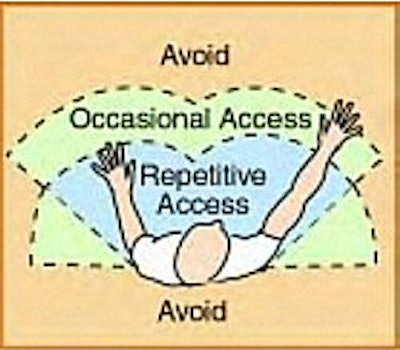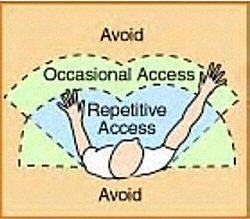
Work-related musculoskeletal disorders (WRMSDs) are increasing both in frequency and severity in sonography. Surveys of American, Canadian, and Australian sonographers have found that roughly 80% of sonographers are scanning in pain. And 20% of these sonographers have been forced to give up their profession as a result of their injuries.
The types of work activities known to cause WRMSD are repetitive motions, forceful exertions, awkward postures, uncomfortable positioning of extremities, frequent reaching above shoulder level, and overuse (Pike I, Russo A, Berkowitz J, et al, "The prevalence of musculoskeletal disorders among diagnostic medical sonographers," Journal of Diagnostic Medical Sonography, September-October 1997, Vol. 13:5, pp. 219-227).
Unfortunately, technical advances in ultrasound have contributed to the increase in WRMSDs. Filmless storage allows sonographers to move rapidly between patients without sufficient rest periods, while increasing workloads have resulted from downsizing, and from chronic shortages of skilled sonographers.
Over time, accumulated exposure to one or more known risk factors leads to injury, because repeated exposure interferes with the body's ability to recover. Muscles contract and relax during movement, allowing blood to circulate, supplying muscles with necessary nutrients and removing toxins (Grieco A, Molteni G, DeVito G, et al, "Epidemiology of musculoskeletal disorders due to biomechanical overload," Ergonomics, September 1998, Vol. 41:9, pp. 1253-1260).
If muscles are constantly contracted due to awkward or fixed postures, they are unable to receive the necessary oxygen and rid themselves of toxins. Pain is the result -- a sign that the muscles are overloaded. Constrained postures cause restricted blood flow to the muscles and a more rapid onset of muscular fatigue that is proportional to the force being exerted.
In addition, oxygen deficiency from vascular constriction reduces the effective working levels of the muscles. Continued exposure can cause inflammation, swelling, and deterioration of tendons and ligaments, further stressing muscles and joints. In sonographers, the most common injuries are carpal and cubital tunnel, epicondylitis of the elbow, shoulder capsulitis and tendinitis, and neck and back strains.
No comparison
The impact of WSRMD ranges from minor discomfort to career-ending injury. There are a number of emotional and financial implications, as well as an impact on the employer and patient care. The cost of implementing an ergonomics program is dwarfed by the cost of a sonographer's work-related injury (Hawkins J, "Survey Seeks to Quantify Technologists' Worth," Advance for Imaging and Radiation Therapy Professional, July 28, 2003, Vol. 11; Soundergonomics.com).
Cost of implementing ergonomics:
- Ultrasound equipment: $180,000
- Exam table: $6,000
- Chair: $750
- Support cushions: $250
- Total: $187,000 (initial purchase)
- Cost per year of ergonomics program, spread over five years: $37,400
Cost of a sonographer sustaining work-related injury:
- Medical bills for average shoulder injury: $20,000 per year
- Workers' compensation: $29,000 average per year
- Replacement staff: $148,000 per year
- Recruiting costs: $10,500
- Loss of exam revenue: $1,170,000 per year
- Total: $1,377,500 per year
Prevention
Treatment for work-related musculoskeletal disorders often have a poor outcome, because the person is sent back to the same work environment that initially produced the injury. Therefore, it's important to prevent these injuries (Evanoff B, Testimony submitted to the United States Senate Committee on Appropriations Subcommittee on Labor, Health and Human Services, and Education Special Hearing on Ergonomics, April 2001).
Education and ergonomics are the keys to prevention. As WRMSDs are caused by multiple factors, injury prevention requires solutions from many sources. Appropriate ergonomic adaptations have been found to effectively reduce the risk of WRMSD symptoms.
Adapting workstations to employees and their work requirements ensures that the workstations function as intended. Productivity is increased if employees' work areas are arranged for their specific body sizes and the types of work being performed.
Sonographers should become aware of what work postures cause pain, and make the necessary changes in their work behaviors. Scanning positions that require wrist flexion or deviation should be avoided; cushions to support their scanning arm should be utilized as often as possible.
Familiarizing themselves with the proper use of adjustable chairs and adjustable exam tables is crucial to optimize scanning position. Sonographers should take the time to adjust patients close to the edge of the exam table and to properly adjust the height of the chair they use during the exam to reduce abduction and reaching of the upper extremities. Position the workstation equipment so that the majority of movement is close to the body to reduce reaching and twisting (see drawing below).
 |
Postures of abduction greater than 30 degrees will increase activation of shoulder and neck muscles, causing fatigue. Fine motor control of the hand is more precise if abduction of the upper arm is reduced so that most of the hand movement is initiated from the forearm rather than the upper arm. Furthermore, heavily loaded muscles are more difficult to control. As a result, neutral postures reduce muscle load, improving precision.
Employers must be aware of schedules and allow adequate breaks for employees. Scanning rooms must be ergonomically designed to reduce the risk of injury to sonographers, including appropriately adjustable ancillary equipment.
Department managers should consider ergonomic design when purchasing new equipment. It may also be possible to modify existing equipment, including ancillary equipment, to make it more ergonomic.
In addition, patient scheduling should be managed so that a variety of exams are scheduled throughout the day, enabling sonographers to use different postures and scanning techniques during the workday. A separate monitor for patient viewing prevents sonographers from being forced into inefficient postures by the sharing of monitors.
Conclusion
Improvements in the ergonomic design of workstations yield an excellent return on investment, providing for better performance, and enhanced employee well-being and morale. Ergonomics provides the foundation for effective management and well-trained workers to perform at their best level, thus supporting good patient care and employee retention.
By Susan L. Murphey
AuntMinnie.com contributing writer
September 13, 2004
Susan L. Murphey is director of operations at Sound Ergonomics, a consulting firm specializing in ergonomics for allied health professionals.
References
"Good ergonomics is good economics," American Federation of Labor-Congress of Industrial Organizations.
"Economics of Ergonomics In Ultrasound," Sound Ergonomics.
Melhorn JM, "Cumulative Trauma Disorders and Repetitive Strain Injuries: The Future," Clinical Orthopaedics & Related Research, June 1998, Vol. 351, pp. 107-126.
Ruess L, O'Connor SC, Cho KH, et al, "Carpal Tunnel Syndrome and Cubital Tunnel Syndrome: Work Related Musculoskeletal Disorders in Four Symptomatic Radiologists," American Journal of Roentgenology, July 2003, Vol. 181:1, pp. 37-42.
Schneider MF, "Ergonomics and Economics: Why ergonomics makes a lot of sense from a dollar-and-cents standpoint and why it may be inevitable because of legislation," Office Ergonomics, May/June 1985.
U.S. Department of Labor Bureau of Labor Statistics
U.S. Department of Labor Occupational Safety and Health Administration
Webster BS, Snook SH, "The cost of compensable upper extremity cumulative trauma disorders," Journal of Occupational Medicine, July 1994, Vol. 36:7, pp. 713-717.
Related Reading
Managing ultrasound ergonomics, March 26, 2004
Suggested Reading
Economics of Ergonomics In Clinical Ultrasound, Sound Ergonomics
Copyright © 2004 Sound Ergonomics



















